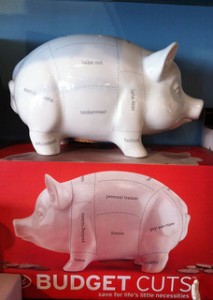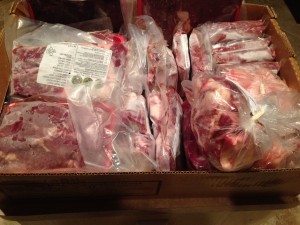 I’ve talked about budget HERE and mentioned several great resource guides on how to eat paleo for cheap, but I still routinely get questions from people concerned about how to implement a whole foods/Paleo on a budget. I understand the concern, nobody lives on unlimited funds (at least I don’t, and none of my clients and friends do either). There will always be a trade off and a necessity for reason and moderation when it comes to budget, and I believe that we must all learn to live within our means. I think that a great deal of the unhappiness and the state of distress running rampant in our society comes from the notion that if we can finance it, we can afford it. I have great respect for the budget, and for anyone concerned with living responsibly within their fiscal situation. But at the same time this question frustrates and pains me, because I think for a lot of people they are selling themselves short, and are unfortunately short sighted about what their food budget (and budget in general) really includes.
I’ve talked about budget HERE and mentioned several great resource guides on how to eat paleo for cheap, but I still routinely get questions from people concerned about how to implement a whole foods/Paleo on a budget. I understand the concern, nobody lives on unlimited funds (at least I don’t, and none of my clients and friends do either). There will always be a trade off and a necessity for reason and moderation when it comes to budget, and I believe that we must all learn to live within our means. I think that a great deal of the unhappiness and the state of distress running rampant in our society comes from the notion that if we can finance it, we can afford it. I have great respect for the budget, and for anyone concerned with living responsibly within their fiscal situation. But at the same time this question frustrates and pains me, because I think for a lot of people they are selling themselves short, and are unfortunately short sighted about what their food budget (and budget in general) really includes.
When we maintain a budget, we’re trying to make our money work for us. If you are what you eat, what is a shitty diet really doing for you? If your money is supposed to work for you, what does that mean if you’re using it to buy cheap garbage food? That money is not really working very hard. Think about the following example: If I gave an employee $20 and asked him to bring me lunch and he served me a big bowl of pasta and a snickers and also bought a coke and some M&Ms for himself, we’d have a very long conversation about proper nutrition and his fiduciary duty to care for my money responsibly. If he continued to do it, I’d fire him. Why would I let him continually disregard my instructions and spend my money on garbage food and treats for himself that don’t meet my needs? And yet so often we let our money flow without looking at the bigger picture, without asking ourselves about the long-term cost/benefit analysis of how we are living. So how do we deal with the cost conundrum and live financially responsible lives filled with nourishing food?
- Prioritize: Ask yourself…What’s your clothing budget? What’s your party/booze budget? What’s your restaurant budget? Are you paying for HBO and Showtime? How often are you hitting up Starbucks for a fix? How much money are you spending on Amazon Prime orders each month? What else is going on the credit card each month that you never really think about? What you prioritize you will make manifest. In order to eat well you may need to sacrifice in some other areas. Consider sitting down and really looking at your budget, figuring out where all your money is going, and think about the consequences to your health if you neglect your nourishment.
- Rethink your current food routine: What are you buying now? Are you buying lots of pre-packaged/ready to eat foods? When you buy something in a box, a bag, a jar or a can, you’re paying for advertising, packaging and shipping along with all the nasty fillers and preservatives that come along with many of them. A lot of times you’re also paying for the food scientists whose professional goal is to find the most potent flavor combinations and chemical enhancements to get you ADDICTED to those foods. When you buy local organic vegetables and grass-fed/pastured meat and eggs, you are paying the farmer in your community to tend to your food with care and treat the animals with respect, which is better for the environment, your community, and your nutrient profile. With a few solid recipes and some simple whole foods, you can remake your entire routine and the price tag may not be that different than what you are paying now. Instead of thinking about just adding more expensive meats and veggies to your bill, think about the kinds of things you can REMOVE. Sometimes, less is more!
- Buy in BULK when you can: This is fairly easy when it comes to nuts, coconut flakes, tuna fish, and veggies, to name a few. Some “super stores” are great about providing organic options (like Costco) and some aren’t, so keep your eyes peeled for the good deals and ask around in your community. If you have access to a deep freezer you can pick up a quarter or half cow or pig-then, in addition to getting a better price cut per pound, you also get some different cuts you wouldn’t regularly have access to which allow you to make some incredibly nourishing traditional foods for less money (like oxtail soup, bone broth (recipe coming soon!) and liver pate).
- Partner up: There are farms that allow you to split the cost of the whole pig/cow (sometimes called a “cow-pool”) between many families so you can get a smaller portion of the animal for the same low price per pound. You can get in on a CSA vegetable share and pool your resources with friends to supplement your current veggie rotation with local in-season organic options. This gets you access to good food at a cheaper price and is also a good option if you want the benefits of variety of good meats but don’t have a huge freezer to keep it all in. If you’re not sure of any farms in your area, check the Weston A. Price Foundation local chapter page for your closest option. They have a wealth of resources on local food options. Here’s an example of what you get when you order 1/10th of a cow (roughly 40lb including cuts ranging from T-bone and ribeye, sirloin, round steak, ground beef, shoulder roast, liver and soup bones)

- The Value is in the WHOLE animal. This often goes hand-in-hand with buying in bulk. Choosing nourishing food does not mean you’re scarfing down super pricey tenderloin and ribeye every night. In fact, eating snout to tail, in addition to offering a ton of super dense nutrients (the vitamin content in pastured liver is through the roof!), there are a ton of super nourishing foods that won’t break the bank. For instance, I routinely use inexpensive round steak in my Thai coconut curries. Chicken wings and thighs, round steak, beef cutlets, oxtail, pork hocks, pork jowel (aka poor man’s bacon), all of these are incredibly nourishing and less expensive than the more well-known, “prime” cuts.
- Think long term: If you think healthy food is expensive, you should see what it costs to be sick! Hospital stays, procedures, testing, expensive medications (side effects of which often require their own medications), the fear and uncertainty that comes with undiagnosed illness, missed work, missed time with loved ones, loss of vitality and disability- there IS a cost to pumping yourself full of junk food. We don’t always see this cost right away but I guarantee you it is there and you will be required to pay in FULL at some point. If you don’t believe me, check out my dad’s story HERE.
It’s both empowering and daunting to think we hold our health in our own hands. It requires a good deal of thought, planning, and self-sacrifice. But when we recognize we are responsible for our health, and that good health (which is different from simple “lack of illness) comes from within and not some prescription or diagnosis and treatment plan, and that the choices we make can have effects on us and our loved ones that last a life time, how can we choose not to act? Acquiescence is condemnation to a life of mediocrity, and we are capable and worthy of so much more than that. Choose health, and take it into your own hands! May you remain nourished and grounded.
What are your favorite budget-friendly tips for eating healthy? Let us know!
Photo credit: OnTask / Foter / Creative Commons Attribution-ShareAlike 2.0 Generic (CC BY-SA 2.0)
 Nourished and Grounded Nutritional and Lifestyle Consulting, Functional Diagnostic Nutrition Practitioner, and MTHFR Expert
Nourished and Grounded Nutritional and Lifestyle Consulting, Functional Diagnostic Nutrition Practitioner, and MTHFR Expert




One comment
Pingback: Guide to Paleo Without Your Partner | Nourished and GroundedNourished and Grounded